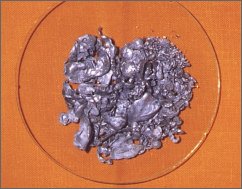Cadmium Poisoning, Which Can Harm Your Kidneys and Reduce Your Bone Density, Surprisingly High
by www.SixWise.com
There was both good and bad news in the Centers for Disease
Control and Prevention's (CDC) monumental "Third National
Report on Human Exposure to Environmental Chemicals."
Good news first. The study, which CDC Director Dr. Julie
Gerberding says is the "largest and most comprehensive
report of its kind ever released anywhere by anyone,"
found that secondhand smoke exposure among Americans has gone
down significantly, as have lead blood levels in children.
|

Smoking is a major source of cadmium exposure.
|
Specifically, from 1999 to 2002, exposure to secondhand smoke,
as measured by median levels of cotinine, a metabolite of
nicotine, decreased (compared to levels from 1988-1991):
And, only 1.6 percent of children between the ages of 1 and
5 had elevated blood lead levels, compared to 4.4 percent
in the early 1990s.
Cadmium Levels Raise Concern
Now for the bad news.
About 5 percent of people aged 20 and over had urinary cadmium
levels at or near levels that may cause health problems. Studies
have found that urine levels of cadmium as low as 1 microgram
per gram of creatinine may be linked to kidney injury and
an increased risk for low bone mineral density.
What is Cadmium?
Cadmium is a metal found naturally in the earth's crust,
but because it reacts readily with other elements like oxygen,
chlorine and sulfur, it's rarely found in pure form.
Certain forms of cadmium, cadmium sulfates and cadmium chlorides
also dissolve extremely easily in water, so much so that they're
rarely found in solid form.
Is Cadmium Dangerous?
|

Cadmium is rarely found in this pure form--it's usually
combined with other elements.
|
Cadmium accumulates in the body and can stay there for many
years. The metal accumulates most often in the bones, liver
and kidneys and can cause damage to these areas. The Department
of Health and Human Services (DHHS) also says that cadmium
and cadmium compounds may "reasonably be anticipated
to be carcinogens."
Other potential health effects include, according to the
Agency for Toxic Substances and Disease Registry (ATSDR):
-
Breathing high levels can cause severe lung damage
and death
-
Eating food or drinking water that contains high levels
can irritate the stomach and lead to vomiting and diarrhea
-
Lower long-term exposure from air, food or water leads
to a buildup of cadmium in the kidneys and may cause kidney
disease
-
Long-term exposure can cause lung damage and fragile
bones
-
Animals given cadmium in food or water had high blood
pressure, iron-poor blood, liver disease, and nerve or
brain damage
Cadmium has been linked to other health risks as well, including:
-
Weakening the immune system
-
Lung cancer
-
Prostate enlargement
-
Reproductive risks including premature birth, low
birth weight, stillbirth and spontaneous abortion
-
Behavioral problems and learning disabilities
How are People Exposed to Cadmium?
More than 90 percent of people's exposure
to cadmium comes from food, according to ATSDR. Low
levels are found in all foods, with shellfish, liver and kidney
meats having the highest levels.
Cigarette smoke is another major source of the metal, and
is absorbed by the body more readily than that from food and
water. Whereas only 5 percent to 10 percent of cadmium from
food is absorbed into the bloodstream, 40 percent to 60 percent
of cadmium inhaled from cigarette smoke is absorbed.
Smoking more than 20 cigarettes a day can increase cadmium
levels by tenfold, and the ATSDR says smoking doubles the
average daily intake of cadmium.
Cadmium is also used in manufacturing batteries, pigments,
metal coatings and plastics, so living near or working in
one of these facilities could increase your exposure through
air or water (it's estimated that 4,000 to 13,000 tons of
cadmium are released into the environment every year due to
such processes). Drinking contaminated water is also a source.
|

Nickel-cadmium batteries should be kept out of children's
reach.
|
How to Reduce Your Exposure
There are ways to reduce your exposure to cadmium, particularly
if you work in a related industry (metal processing, electroplating,
battery manufacture, ore refineries). If this applies to you,
be sure to carefully follow all workplace safety procedures.
Also take special care not to bring cadmium dust into your
home via shoes, clothing and tools. You may also want to shower
when you get home to remove any dust on your body and hair.
For everyone, to reduce cadmium exposure to yourself and
your family:
-
Store products that contain cadmium (nickel-cadmium
batteries, fertilizers) safely out of children's reach
-
Use cadmium products only as instructed
-
Limit consumption of shellfish and liver
-
Eat a balanced, healthy diet, as that is your main
weapon to strengthen your immune system
Recommended Reading
Bottled
Water: Which City's Tap Water System is Making a Flood of
Cash off of You?
Radon's Real Risk:
1 in 15 Homes Polluted with this #2 Cause of Lung Cancer,
but Most Don't Know It!
Sources
Excite
Health July 21, 2005
HealthOrbit
July 21, 2005
Dartmouth
Toxic Metal Research
Agency
for Toxic Substances and Disease Registry